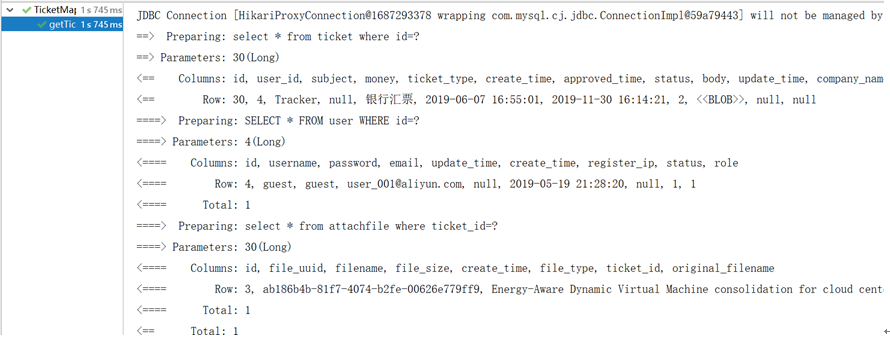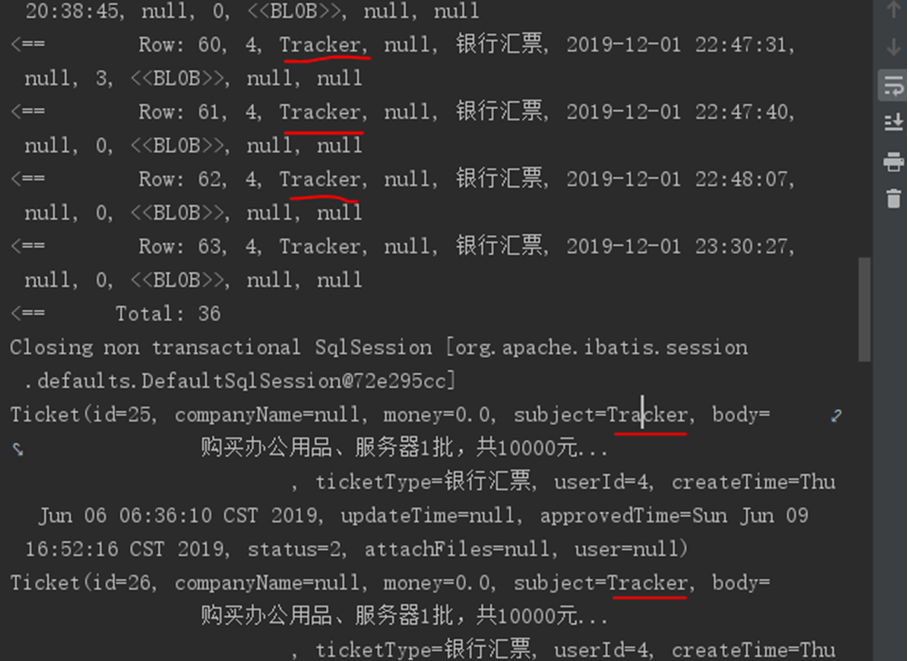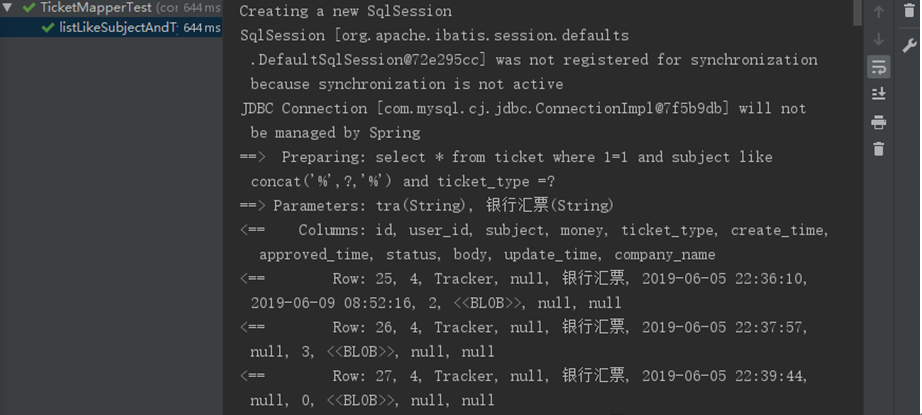SpringBoot---基于Mybatis的数据持久层技术(包括注解和xml文件格式实现添删查改、懒加载配置、一对一,一对多查询、模糊查询、动态查询)
整合SpringBoot与Mybatis
1、创建一个Spring Boot项目。pom配置文件中添加依赖,这里我们采用了阿里巴巴的Druid连接池
<!-- 阿里巴巴的Druid数据源依赖启动器 -->
<dependency> <groupId>com.alibaba</groupId> <artifactId>druid-spring-boot-starter</artifactId> <version>1.1.14</version> </dependency>
<!-- Mybatis启动器 -->
<dependency> <groupId>org.mybatis.spring.boot</groupId> <artifactId>mybatis-spring-boot-starter</artifactId> <version>2.1.2</version> </dependency>
<!-- MySQL数据库连接驱动 -->
<dependency> <groupId>mysql</groupId> <artifactId>mysql-connector-java</artifactId> <scope>runtime</scope> </dependency>
2、在application.yml 配置文件中添加相关的数据库连接配置
# Mysql 数据库连接配置 spring: datasource: url: jdbc:mysql://localhost:3306/mybatis?useUnicode=true&characterEncoding=utf8&serverTimezone=UTC&useSSL=false&serverTimezone=Asia/Shanghai # 数据库端口号/数据库名?各种参数 username: root password: 123456 # 添加并配置第三方数据源druid type: com.alibaba.druid.pool.DruidDataSource initialSize: 20 minIdle: 10 maxActive: 100 # 配置MyBatisi的xml配置文件路径 mybatis: mapper-locations: classpath:mapper/*.xml type-aliases-package: com.zsc.mybatisi.demo1.domain #配置XML映射文件中指定的实体类别名路径 configuration: log-impl: org.apache.ibatis.logging.stdout.StdOutImpl #输出执行的SQL语句 map-underscore-to-camel-case: true #开启驼峰命名匹配映射
注意:在配置数据库的url的时候要在后面加上参数以防乱码(?useUnicode=true&characterEncoding=utf8&serverTimezone=UTC&useSSL=false)
# serverTimezone=Asia/Shanghai使用上海时区 之前是使用UTC时区,但是插入数据库会和电脑时间不一样,少8个小时
3、在数据库中创建 t_article和t_comment两张表,并添加一些数据
CREATE TABLE `t_article` ( `id` int(20) NOT NULL AUTO_INCREMENT COMMENT '文章id', `title` varchar(200) DEFAULT NULL COMMENT '文章标题', `content` longtext COMMENT '文章内容', PRIMARY KEY (`id`) ) ENGINE=InnoDB AUTO_INCREMENT=2 DEFAULT CHARSET=utf8; INSERT INTO `t_article` VALUES ('1', 'Spring Boot基础入门', '从入门到精通讲解...'); INSERT INTO `t_article` VALUES ('2', 'Spring Cloud基础入门', '从入门到精通讲解...'); CREATE TABLE `t_comment` ( `id` int(20) NOT NULL AUTO_INCREMENT COMMENT '评论id', `content` longtext COMMENT '评论内容', `author` varchar(200) DEFAULT NULL COMMENT '评论作者', `a_id` int(20) DEFAULT NULL COMMENT '关联的文章id', PRIMARY KEY (`id`) ) ENGINE=InnoDB AUTO_INCREMENT=3 DEFAULT CHARSET=utf8; INSERT INTO `t_comment` VALUES ('1', '很全、很详细', '狂奔的蜗牛', '1'); INSERT INTO `t_comment` VALUES ('2', '赞一个', 'tom', '1'); INSERT INTO `t_comment` VALUES ('3', '很详细', 'kitty', '1'); INSERT INTO `t_comment` VALUES ('4', '很好,非常详细', '张三', '1'); INSERT INTO `t_comment` VALUES ('5', '很不错', '张杨', '2');
4、创建表对应的实体类

/**评论实体类*/ @Data
@TableName("t_comment") // 数据库表名 public class Comment implements Serializable{
@TableId("id") // 数据库主键字段 private Integer id;
@TableField("content") // 数据库非主键字段 private String content; private String author; private Integer aId;
//@TableField("expire_date") // 数据库非主键字段
//@JsonFormat(pattern = "yyyy-MM-dd HH:mm:ss") // 日期格式自动化
//private Date expireDate;
}
/** 文章实体类 */ @Data
@TableName("t_article") // 数据库表名 public class Article implements Serializable{
@TableId("id") // 数据库主键字段 private Integer id;
@TableField("title") // 数据库非主键字段 private String title; private String content; private List<Comment> commentList; }
5、基于注解方式实现对评论的增删改查,在mapper文件夹中编写评论的Mapper接口文件。
@Mapper public interface CommentMapper { //插入评论数据 @Insert("insert into t_comment(content,author,a_id) "+"values (#{content},#{author},#{aId})") int insertComment(Comment comment); //删除 @Delete("delete from t_comment where id=#{id}") int deleteComment(Integer id); //查询 @Select("select * from t_comment where id=#{id}") Comment findById(Integer id); //更新 @Update("update t_comment set content=#{content} shere id=#{id}") int updateComment(Comment comment); }
6、编写测试方法进行接口方法测试。
@SpringBootTest @RunWith(SpringRunner.class) public class CommentMapperTest { @Autowired CommentMapper commentMapper; @org.junit.Test public void findById() { Comment comment=commentMapper.findById(1); System.out.println(comment.toString()); } }

7、基于配置文件方式实现对文章的增删改查,与注解方式不同的是我们除了要编写Mapper接口还要编写Mapper.xml映射文件
ArticleMapper接口
@Mapper public interface ArticleMapper { //根据id查询文章 Article selectArticle( Integer id); //更新文章数据 int updateArticle(Article article); }
ArticleMapper.xml
<?xml version="1.0" encoding="UTF-8"?> <!DOCTYPE mapper PUBLIC "-//mybatis.org//DTD Mapper 3.0//EN" "http://mybatis.org/dtd/mybatis-3-mapper.dtd"> <mapper namespace="com.zsc.mybatisi.demo1.mapper.ArticleMapper"> <resultMap id="articleWithComment" type="Article"> <id property="id" column="id"/> <result property="title" column="title"/> <result property="content" column="content"/> <collection property="commentList" ofType="Comment"> <id property="id" column="c_id"/> <result property="content" column="c_content"/> <result property="author" column="author"/> </collection> </resultMap> <select id="selectArticle" resultMap="articleWithComment"> select a.*,c.id c_id,c.content c_content,c.author from t_article a,t_comment c where a.id=c.a_id and a.id=#{id} </select> <update id="updateArticle" parameterType="Article"> update t_article <set> <if test="title !=null and title !=''">title=#{title},</if> <if test="content !=null and content !=''">content=#{content}</if> </set> where id=#{id} </update> </mapper>
8、编写单元测试方法进行接口方法测试。
@SpringBootTest @RunWith(SpringRunner.class) public class ArticleMapperTest { @Autowired ArticleMapper articleMapper; @Test public void TestArticle() { Article article=articleMapper.selectArticle(1); System.out.println(article); article.setContent("修改文字内容"); articleMapper.updateArticle(article); Article updateArticle=articleMapper.selectArticle(1); System.out.println(updateArticle); } }
测试结果

使用ResutlMap实现一对多、多对多的对象关联
(1)1对1 关联 ,使用assosication,一个票据只能对应一个User,因此使用assosication与用户对象进行关联。Property为Ticket对象中关联的user属性,而Column表示关联到User表的外键。JavaType表示关联对象类型为User,select表示调用对应的接口get查询User对象。
(2)1对n 关联 ,使用collection,一个票据对应多个AttachFile,因此使用collection与附件对象进行关联。Property为Ticket对象中关联的AttachFile属性,而Column表示关联到attachfile表的外键。ofType表示关联对象类型为AttachFile,select表示调用接口listByTicketId查询attachFile对象。
1、实体类 AttachFile(附件实体类)、Ticket(票据实体类)、User(用户实体类)
@Data public class AttachFile { Long id; //主键 String fileUUID; //文件的UUID String filename; //保存后的文件名 String originalFilename; //源文件名 String fileSize; //文件大小 Date create; //上传时间 String fileType; //文件类型 Long ticketId; //票据Id(外键) }
@Data public class Ticket { //票据用户 Long id; //票据Id(主键) String companyName; //客户名称 double money; //票据金额 String subject; //票据主题 String body; //票据主要内容 String ticketType; //票据类型 Long userId; //提交者名字 Date createTime; //提交时间 Date updateTime; //审核时间 Date approvedTime; //审核时间 int status; //状态 List<AttachFile>attachFiles; //票据附件 User user; //票据用户 }
@Data public class User{ //用户角色、role=0表示管理员、role=1表示普通用户 Long id; //id String username; //用户名 String password; //密码 String email; //电子邮件 Date createTime; //注册时间 Date updateTime; //更新时间 String registerIp; //注册id Integer status; //状态 0:用户停用 1:用户激活 Integer role; //用户角色 0:管理者 1:普通用户 }
2、Mapper接口
@SuppressWarnings("ALL")
@Mapper public interface TicketMapper { //查询票据及其附件 public Ticket getTicketDetails(Long id); }
@SuppressWarnings("ALL")
@Mapper public interface AttachFileMapper { //根据ticketId查找附件 @Select("select * from attachfile where id=#{id}") public List<AttachFile> listByTicketId(Long id); }
@SuppressWarnings("ALL")
@Mapper
public interface UserMapper {
//根据id获取用户对象,如果不存在返回null
@Select("select * from user where id=#{id}")
public User get(@Param("id") Long id);
}
3、mapper.xml
注意:
(1)<select id="getTicketDetails" parameterType="Long" resultMap="Ticket_User_AttachFile">
id对应的值是mapper接口里的方法名,parameterType对应的是方法内的参数类型,resultMap对应的是返回值类型 ,一般是实体类路径和resultMap的id值(这里对应的是resultMap的id值)。
(2)<association property="user" column="user_id" javaType="User" select="com.zsc.ticketsys.mapper.UserMapper.get"/>
property对应的是Ticket实体类的属性,column是查询出来的表的列名,同时对应的是要传的值,javaType对应的是返回类型 ,select对应的是查询方法
(3)<collection property="attachFiles" column="id" ofType="AttachFile" select="com.zsc.ticketsys.mapper.AttachFileMapper.listByTicketId"/>
同(2),其中,ofType是返回的类型。
<?xml version="1.0" encoding="UTF-8" ?> <!DOCTYPE mapper PUBLIC "-//mybatis.org//DTD Mapper 3.0//EN" "http://mybatis.org/dtd/mybatis-3-mapper.dtd"> <!-- namespace表示命名空间 --> <mapper namespace="com.zsc.ticketsys.mapper.TicketMapper"> <select id="getTicketDetails" parameterType="Long" resultMap="Ticket_User_AttachFile"> select * from ticket where id=#{id} </select> <!-- 定义一个ResultMap 封装查询结果--> <resultMap id="Ticket_User_AttachFile" type="Ticket"> <id property="id" column="id"/> <!-- 用户对象1对1关联--> <association property="user" column="user_id" javaType="User" select="com.zsc.ticketsys.mapper.UserMapper.get"/> <!-- 附件对象1对多关联--> <collection property="attachFiles" column="id" ofType="AttachFile" select="com.zsc.ticketsys.mapper.AttachFileMapper.listByTicketId"/> </resultMap> </mapper>
4、测试
@SpringBootTest @RunWith(SpringRunner.class) public class TicketMapperTest { @Autowired TicketMapper ticketMapper; @Test public void getTicketDetails() { Ticket ticket=ticketMapper.getTicketDetails(30L); System.out.println(ticket.getCompanyName()); } }

懒加载
注意:为了避免关联对象立即加载问题,可以在配置文件中使用懒加载的方式。懒加载只在加载对象时不会立即加载该对象的关联对象,而只有在调用如get()等方法才会进行加载。懒加载时性能优化的一种方式。
启动懒加载
#配置Mybatis的相关属性 mybatis: #指定mapper XML文件的位置 mapper-locations: classpath:com.zsc.ticketsys.mapper/*.xml #指定实体类的别名的映射路径 type-aliases-package: com.zsc.ticketsys.domain configuration: #打印输出SQL语句 log-impl: org.apache.ibatis.logging.stdout.StdOutImpl # 启动驼峰式转换 map-underscore-to-camel-case: true #开启自增组件 use-generated-keys: true #启动懒加载 lazy-loading-enabled: true #禁用立即加载 aggressive-lazy-loading: false
实现模糊查询和动态查询
1、实现票据主题的模糊查询。在mapper接口类中定义方法
@Mapper public interface TicketMapper { //根据主题进行迷糊查询 public List<Ticket> listLikeSubject(String subject); }
2、在ticketMpper.xml文件中编写对应的实现内容
<!--进行模糊查询--> <select id="listLikeSubject" parameterType="String" resultType="Ticket"> select * from ticket where Subject like concat('%' ,#{subject},'%') </select>
3、结果测试,用tra查询出来的结果

4、实现动态查询,动态拼接SQL查询语句。在mapper接口类中定义方法和XML的内容如下:
//根据主题和类型进行查询 public List<Ticket> listLikeSubjectAndType(String subject,String type);
<!--动态查询--> <select id="listLikeSubjectAndType" parameterType="String" resultType="Ticket"> select * from ticket where 1=1 <if test="subject !=null and type!=''">and subject like concat('%',#{subject},'%')</if> <if test="type !=null and type !=''">and ticket_type =#{type}</if> </select>
5、测试。测试用例:票据主题:tra(模糊词汇)、票据类型:银行汇票

源码:
链接:https://pan.baidu.com/s/1k_vsOqfqb-7q7h5C5EnKFg
提取码:ox1s




 浙公网安备 33010602011771号
浙公网安备 33010602011771号